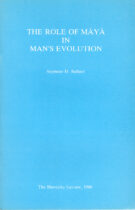The Role of Māyā in Man’s Evolution
19 Pages | Softcover | The Blavatsky Lecture, 1986 | The Theosophical Society in England, London | No ISBN.
The Blavatsky Lecture delivered at the Annual Convention of the Theosophical Society in England at the College of Ripon and York, St. John, Ripon, July 29th, 1986.
A vital feature of the esoteric traditions contains the notion that all manifestation is to be regarded as illusion. Illusion is the usual translation of the Sanskrit word māyā. Yet, although she uses this definition of the Sanskrit Helena Petrovna Blavatsky (1831 – 1891) presents important qualifications to the word to help the student fathom the subject matter in her major work. She writes: ‘Māyā or Illusion, is an element which enters into all finite things, for everything that exists has only a relative, not an absolute, reality, since the appearance which the hidden noumenon assumes for any observer depends upon his power of cognition…’
From page 4:
” Nothing is permanent except the one hidden absolute Existence which contains in itself the noumena of all realities. The existences belonging to every plane of being, up to the highest Dhyan Chohans, are, comparatively, like the shadows cast by a magic lantern on a colourless screen. Nevertheless, all things are relatively real, for the cognizer is also a reflection, and the things cognised are therefore as real to him as himself. Whatever reality things possess, must be looked for in them before or after they have passed like a flash through the material world; for we cannot cognize any such existence directly, so long as we have sense instruments, which bring only material existences into the field of our consciousness. “
 Bezig met bijwerken…
Bezig met bijwerken…